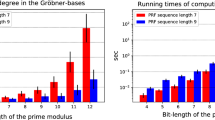Abstract
Let p be a prime and let a and c be integers modulo p. The quadratic congruential generator (QCG) is a sequence (v n ) of pseudorandom numbers defined by the relation \(v_{n+1}\equiv av^{2}_{n}+c mod p\). We show that if sufficiently many of the most significant bits of several consecutive values v n of the QCG are given, one can recover in polynomial time the initial value v 0 (even in the case where the coefficient c is unknown), provided that the initial value v 0 does not lie in a certain small subset of exceptional values.
Preview
Unable to display preview. Download preview PDF.
Similar content being viewed by others
References
Ajtai, M., Kumar, R., Sivakumar, D.: A sieve algorithm for the shortest lattice vector problem. In: Proc. 33rd ACM Symp. on Theory of Comput (STOC 2001). Association for Computing Machinery, pp. 601–610 (2001)
Blackburn, S.R., Gomez-Perez, D., Gutierrez, J., Shparlinski, I.E.: Predicting the inversive generator. In: Paterson, K.G. (ed.) Cryptography and Coding 2003. LNCS, vol. 2898, pp. 264–275. Springer, Heidelberg (2003)
Blackburn, S.R., Gomez-Perez, D., Gutierrez, J., Shparlinski, I.E.: Predicting nonlinear pseudorandom number generators. Math. Computation 74, 1471–1494 (2005)
Brickell, E.F., Odlyzko, A.M.: Cryptanalysis: A survey of recent results. In: Contemp. Cryptology, pp. 501–540. IEEE Press, NY (1992)
Grötschel, M., Lovász, L., Schrijver, A.: Geometric algorithms and combinatorial optimization. Springer, Berlin (1993)
Joux, A., Stern, J.: Lattice reduction: A toolbox for the cryptanalyst. J. Cryptology 11, 161–185 (1998)
Kannan, R.: Algorithmic geometry of numbers. Annual Review of Comp. Sci. 2, 231–267 (1987)
Kannan, R.: Minkowski’s convex body theorem and integer programming. Math. Oper. Res. 12, 415–440 (1987)
Lagarias, J.C.: Pseudorandom number generators in cryptography and number theory. In: Proc. Symp. in Appl. Math., Amer. Math. Soc., Providence, RI, vol. 42, pp. 115–143 (1990)
Lenstra, A.K., Lenstra, H.W., Lovász, L.: Factoring polynomials with rational coefficients. Mathematische Annalen 261, 515–534 (1982)
Micciancio, D., Goldwasser, S.: Complexity of lattice problems. Kluwer Acad. Publ., Dordrecht (2002)
Nguyen, P.Q., Stern, J.: Lattice reduction in cryptology: An update. In: Bosma, W. (ed.) ANTS 2000. LNCS, vol. 1838, pp. 85–112. Springer, Heidelberg (2000)
Nguyen, P.Q., Stern, J.: The two faces of lattices in cryptology. In: Silverman, J.H. (ed.) CaLC 2001. LNCS, vol. 2146, pp. 146–180. Springer, Heidelberg (2001)
Niederreiter, H.: New developments in uniform pseudorandom number and vector generation. In: Niederreiter, H., Shiue, P.J. (eds.) Monte Carlo and Quasi-Monte Carlo Methods in Scientific Computing. Lect. Notes in Statistics, vol. 106, pp. 87–120. Springer, Berlin (1995)
Niederreiter, H.: Design and analysis of nonlinear pseudorandom number generators. In: Schueller, G.I., Spanos, P.D. (eds.) Monte Carlo Simulation, pp. 3–9. A.A. Balkema Publishers, Rotterdam (2001)
Niederreiter, H., Shparlinski, I.E.: Recent advances in the theory of nonlinear pseudorandom number generators. In: Fang, K.-T., Hickernell, F.J., Niederreiter, H. (eds.) Proc. Conf. on Monte Carlo and Quasi-Monte Carlo Methods, pp. 86–102. Springer, Berlin (2002)
Niederreiter, H., Shparlinski, I.E.: Dynamical systems generated by rational functions. In: Fossorier, M.P.C., Høholdt, T., Poli, A. (eds.) AAECC 2003. LNCS, vol. 2643, pp. 6–17. Springer, Heidelberg (2003)
Author information
Authors and Affiliations
Editor information
Editors and Affiliations
Rights and permissions
Copyright information
© 2005 Springer-Verlag Berlin Heidelberg
About this paper
Cite this paper
Gomez, D., Gutierrez, J., Ibeas, A. (2005). Cryptanalysis of the Quadratic Generator. In: Maitra, S., Veni Madhavan, C.E., Venkatesan, R. (eds) Progress in Cryptology - INDOCRYPT 2005. INDOCRYPT 2005. Lecture Notes in Computer Science, vol 3797. Springer, Berlin, Heidelberg. https://doi.org/10.1007/11596219_10
Download citation
DOI: https://doi.org/10.1007/11596219_10
Publisher Name: Springer, Berlin, Heidelberg
Print ISBN: 978-3-540-30805-8
Online ISBN: 978-3-540-32278-8
eBook Packages: Computer ScienceComputer Science (R0)




